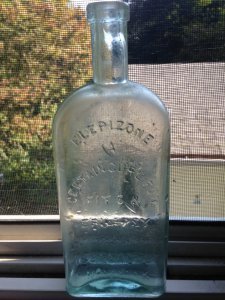Quacks Pretend To Cure Other Men’s Disorders But Rarely Find A Cure For Their Own – Part Forty Six
Cures for epilepsy
Epilepsy, characterised by dramatic and frightening fits, has afflicted humans since at least the dawn of recorded history. A Mesopotamian script dating to around 2,000 BCE has the first recorded description of a fit and the Code of Hammurabi (circa 1790 BCE) allowed the owner to get a refund for a slave if they suffered from epilepsy. The ancient Greeks saw someone suffering from epilepsy as being possessed by genius and the gods.
Medical knowledge until the last century was such that epilepsy was barely understood, let alone treatable or preventable. This sad state of affairs meant that it was a fertile ground for the practitioners of quackery to operate in. One such was a “Dr” Root – it is by no means certain he had any medical qualifications and dropped the title sometime in the 1890s – who offered a remedy called Elepizone, which consisted of the bromides of sodium, ammonium and potassium, together with nux vomica which contains strychnine, caramel and wintergreen water.
As we have come to expect, the advertising of the product was fulsome, as this one dating from 1888 shows. “I CURE FITS” it screamed, adding as a gloss “When I say cure I do not mean merely to stop them for a time and then have them return again. I mean a radical cure” Claiming to have made a study of fits and epilepsy, Root declared, “I warrant my remedy to cure the worst cases”. If this was not inducement enough to respond, Root offered a free bottle of his “infallible remedy” to those who responded by post. Why not? After all, as the advert helpfully pointed out, “It costs you nothing for a trial and it will cure you”.
Root originated from Springfield, Ohio and appeared aged 35 and listed as a vendor of patent medicines there in the 1870 census. He appears to have sold his business together with the right to use his name to another quack, T A Slocum who was flogging Psychnine as a cure for consumption and lung troubles. Slocum and Root then seemed to share addresses – whether they were working in partnership is unclear. A London chemist, Thomas Francis Elton, was recorded as acting as an agent for both Slocum and Root.
They did not have the field to themselves. A K Hollowell offered Dr Lindley’s Epilepsy Remedy which, according to the adverts, was a “positive remedy for epilepsy, fits, spasms, convulsions and St Vitus’ Dance”. In reality it was only bromides and alcohol in water. The so-called Dr Peebles’ Institute of Health in Michigan – actually run by a quack called W T Bobo – offered a Brain Restorative – bromides in an alcoholic preparation with valerian – and Nerv-Tonic, a sweetened water and alcohol solution of vegetable products.
Other remedies available were effectively sedatives using bromides such as Hunter’s Epilepsy Cure and Doctor Croney’s Specific for Epilepsy whilst others relied on phenobarbital such as Epilepson and Maghee’s Epilepsy Treatment. Whilst they might have been on the right track – phenobarbital is a cheap and commonly used anti-convulsant these days – many of these so-called remedies fell foul of the American Food and Drug Act of 1907. As the American Medical Association said at the time, purchasers confused temporary suppression of epilepsy by the powerful sedatives with a cure but, actually, were subjecting themselves to great danger. Quackery in a nutshell.
Filed under: Culture, History Tagged: bromides and epilespy, Dr Henry Root, Dr peebles' Institute of Health in Michigan, Elepizone, epilepsy and the Code of Hammurabi, first recorded case of epilepsy, phenobarbital, T A Slocum












